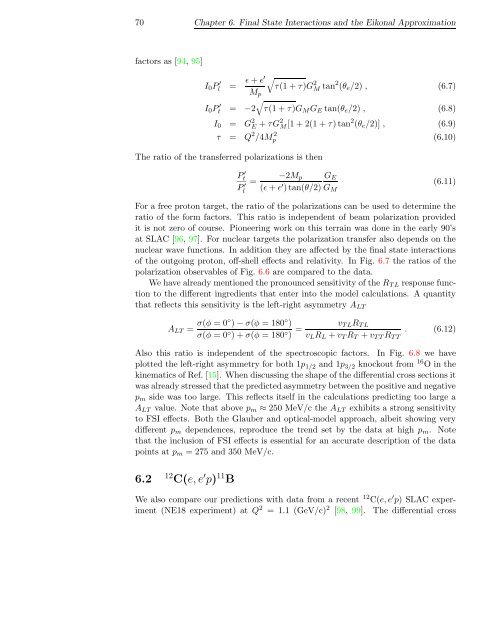Download Thesis in Pdf Format - Theoretical Nuclear Physics and ...
Download Thesis in Pdf Format - Theoretical Nuclear Physics and ...
Download Thesis in Pdf Format - Theoretical Nuclear Physics and ...
You also want an ePaper? Increase the reach of your titles
YUMPU automatically turns print PDFs into web optimized ePapers that Google loves.
70 Chapter 6. F<strong>in</strong>al State Interactions <strong>and</strong> the Eikonal Approximation<br />
factors as [94, 95]<br />
I 0 P l ′ = ɛ + ɛ′ √<br />
τ(1 + τ)G 2 M tan 2 (θ e /2) , (6.7)<br />
M p<br />
√<br />
I 0 P t ′ = −2 τ(1 + τ)G M G E tan(θ e /2) , (6.8)<br />
I 0 = G 2 E + τG 2 M[1 + 2(1 + τ) tan 2 (θ e /2)] , (6.9)<br />
τ = Q 2 /4M 2 p (6.10)<br />
The ratio of the transferred polarizations is then<br />
P ′ t<br />
P ′<br />
l<br />
=<br />
G E<br />
−2M p<br />
(ɛ + ɛ ′ (6.11)<br />
) tan(θ/2) G M<br />
For a free proton target, the ratio of the polarizations can be used to determ<strong>in</strong>e the<br />
ratio of the form factors. This ratio is <strong>in</strong>dependent of beam polarization provided<br />
it is not zero of course. Pioneer<strong>in</strong>g work on this terra<strong>in</strong> was done <strong>in</strong> the early 90’s<br />
at SLAC [96, 97]. For nuclear targets the polarization transfer also depends on the<br />
nuclear wave functions. In addition they are affected by the f<strong>in</strong>al state <strong>in</strong>teractions<br />
of the outgo<strong>in</strong>g proton, off-shell effects <strong>and</strong> relativity. In Fig. 6.7 the ratios of the<br />
polarization observables of Fig. 6.6 are compared to the data.<br />
We have already mentioned the pronounced sensitivity of the R T L response function<br />
to the different <strong>in</strong>gredients that enter <strong>in</strong>to the model calculations. A quantity<br />
that reflects this sensitivity is the left-right asymmetry A LT<br />
A LT = σ(φ = 0◦ ) − σ(φ = 180 ◦ )<br />
σ(φ = 0 ◦ ) + σ(φ = 180 ◦ ) =<br />
v T L R T L<br />
v L R L + v T R T + v T T R T T<br />
. (6.12)<br />
Also this ratio is <strong>in</strong>dependent of the spectroscopic factors. In Fig. 6.8 we have<br />
plotted the left-right asymmetry for both 1p 1/2 <strong>and</strong> 1p 3/2 knockout from 16 O <strong>in</strong> the<br />
k<strong>in</strong>ematics of Ref. [15]. When discuss<strong>in</strong>g the shape of the differential cross sections it<br />
was already stressed that the predicted asymmetry between the positive <strong>and</strong> negative<br />
p m side was too large. This reflects itself <strong>in</strong> the calculations predict<strong>in</strong>g too large a<br />
A LT value. Note that above p m ≈ 250 MeV/c the A LT exhibits a strong sensitivity<br />
to FSI effects. Both the Glauber <strong>and</strong> optical-model approach, albeit show<strong>in</strong>g very<br />
different p m dependences, reproduce the trend set by the data at high p m . Note<br />
that the <strong>in</strong>clusion of FSI effects is essential for an accurate description of the data<br />
po<strong>in</strong>ts at p m = 275 <strong>and</strong> 350 MeV/c.<br />
6.2 12 C(e, e ′ p) 11 B<br />
We also compare our predictions with data from a recent 12 C(e, e ′ p) SLAC experiment<br />
(NE18 experiment) at Q 2 = 1.1 (GeV/c) 2 [98, 99]. The differential cross















